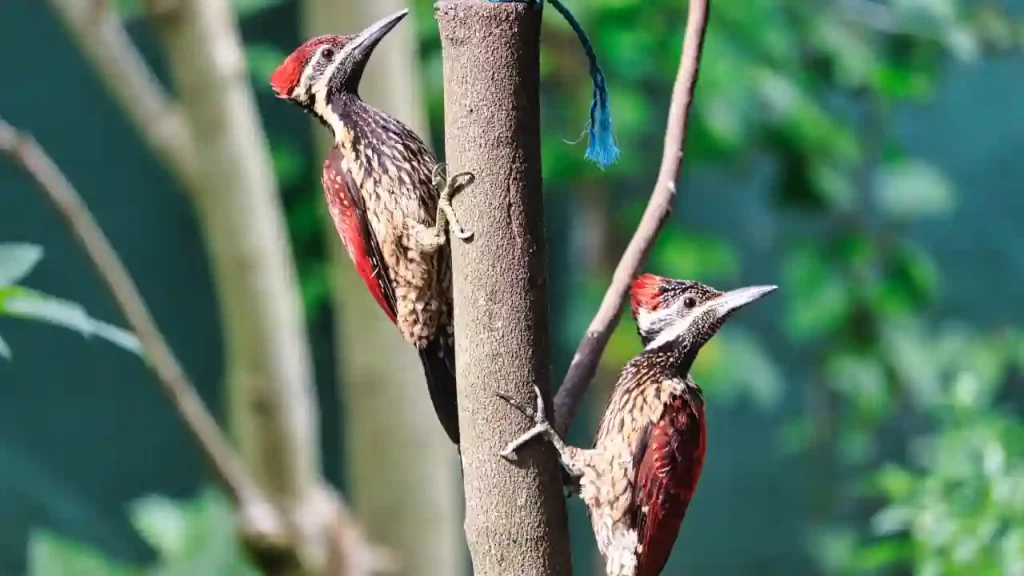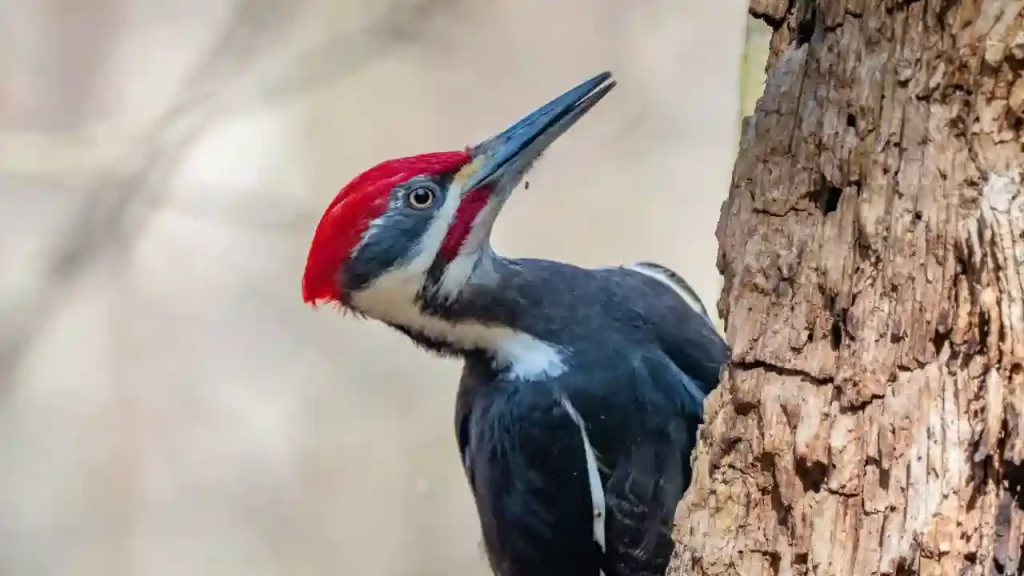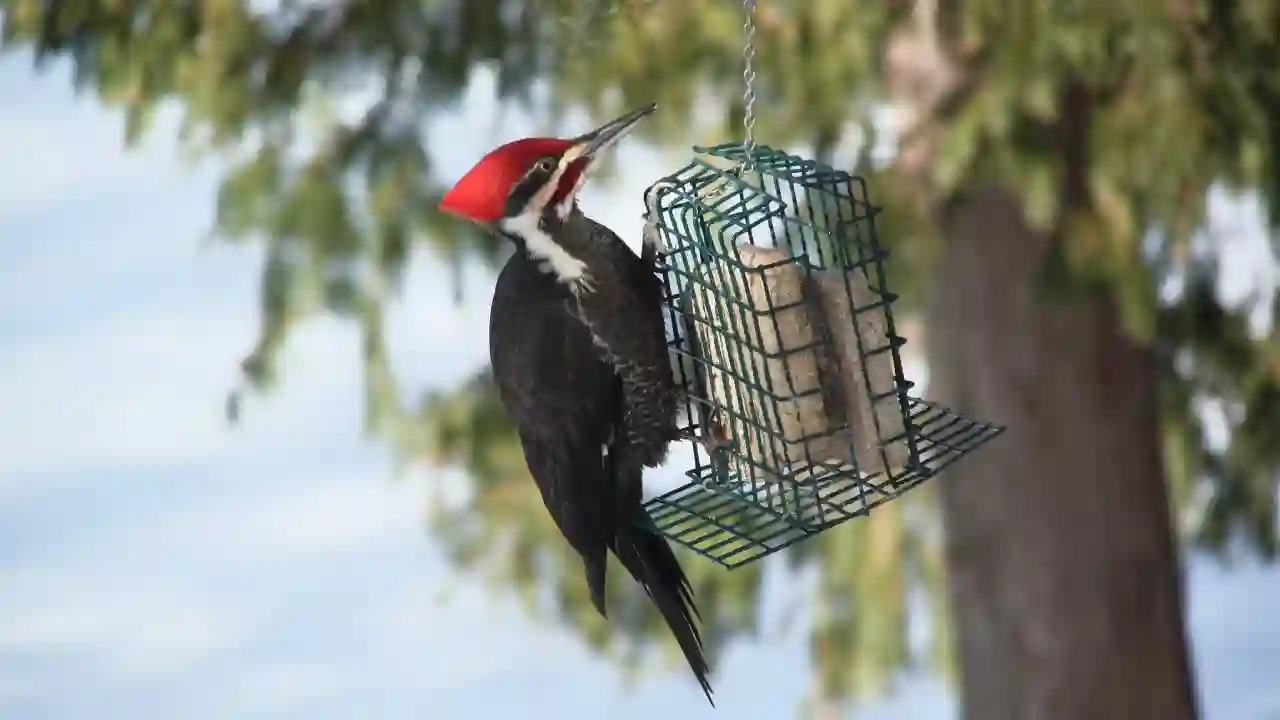Spotting a pileated woodpecker may not be as difficult as you thought. They are of least concern on the conservation status, so catching a glimpse of them in woodlands and forests should be easy enough; just follow the hammering sound, and at the end, you should see a large black bird with a flaming red crest upon its head.
The pileated woodpecker is a large bird that is mostly black with lightning strips of white on its face and under the wings. There are very few differences between females and males, apart from the red crest on their heads and the red mustache that only the males show.
In certain species, identifying between male and female can be virtually impossible as they are identical; take the Blue Jay, for instance.
But in some species, small differences can help you tell the difference between males and females, although minimal. Below we look at the difference between the male and female Pileated woodpeckers.
How To Identify Between Male & Female Pileated Woodpeckers?
The pileated woodpecker is a shy solitary bird but can be found in pairs once they find a mate.
They are monogamous and pair for life, raising broods together and assisting each other with the nest building.
Size – Male vs Female Woodpecker
Adult pileated woodpeckers grow up to about 16 to 19 inches, with a wingspan of 26 to 30 inches.
The male weighs about 11oz, with the females slightly smaller at 9oz, making them the largest living woodpeckers in Northern America and placing them just under the crow on the size chart.
However, the size difference between the male and female is so small that telling them apart is a bit tricky unless they are perched next to each other.
Appearance – Male vs Female Woodpecker

Both male and female pileated woodpeckers have black feathers with a distinct red-capped crest and white stripes across their face, with a slight variation of the stripe on the cheek.
Crest
But this is where the males differ slightly from the females; males have a bright red crest that extends up to the beak, whereas on the female, the brightly red-crested cap doesn’t go lower than the fore crown. On the females, the fore crown is a black, grey color.
Cheek
Another distinct feature that sets the two apart and makes distinguishing them easier is the bright red stripe, also called mustache, visible across their cheek, as opposed to the females that sport a black stripe across their cheeks.
Physical Attributes – Male vs Female Woodpecker

Although there is very little difference between males and females in their physical attributes, they still have some amazing features that help them with their daily routine.
Feet And Claws
The pileated woodpecker’s toes are slightly different from that of other birds. Although they have four toes like every other bird, they have zygodactyl feet with two toes pointing forward and two toes pointing backward with sharp claws resembling the same feet of a parrot.
The back toes offer these birds a better balance when they hang onto a tree while they forage for food under the bark of trees or when they are hollowing out dead trees for nests.
Head
Pileated woodpeckers have extremely strong necks that help drive their heads when chiseling away at trees and bark. Their skull has a section of spongy bone that pads their brain, eyes, and ears from heavy hammering.
Beak
The males and females have the same long, strong chisel-shaped beaks ideal for drilling into bark and wood for foraging and nesting. Their beak is designed to withstand the constant hammering of up to 12,000 times a day; now that’s using your head!
Tongue
Their tongues are quite different from normal birds and have a double benefit. Pileated woodpeckers’ tongues are three times the length of their beaks.
It is sticky as they produce a large amount of saliva to ensure their prey doesn’t slip away and are also equipped with small bards at the end that helps them to spear the grubs and worms inside hard-to-reach cavities of drilled wood.
But where on earth do they store that tongue into? They have a cavity in their skull that goes around their head where the tongue retracts. This is also beneficial to the bird to protect their brains from all the hammering they do.
Eyes
As juveniles, the pileated woodpeckers have brown eyes that turn yellow as they mature. I always think of them having a bit of a staring startled eye.
Have you ever seen a pileated woodpecker with goggles? I haven’t, so how do they protect their eyes from wood chips when drilling burrows?
They have nictitating membranes that act as natural goggles when they chip away at a tree. Beneath the external eyelid is an extra-thin transparent eyelid that closes horizontally every time they hammer, so in layman’s terms, they are really blinking very fast.
This membrane keeps the bird’s eyes protected from chips and dust and keeps their eyes moist. It also acts as a safety belt as such, holding back the eye when the deceleration occurs as they hammer into the bark.
Tail Feathers
Pileated woodpeckers also have an adaptable support feature from their tail.
Their tail feathers are stiff and act as a support prop for climbing trees or as a stabilizer when they start to drill into the tree, acting as a third leg.
Behavior Of Pileated Woodpeckers

Pileated woodpeckers are solitary birds found in pairs once they choose a mate. In the mating season, it is not uncommon to see males congregate together as they fight over territory and for female affection.
Males will defend their territory throughout the year but will be less aggressive during winter if other woodpeckers are found in their range.
As with any other animal, pileated woodpeckers have emotions and moods that can be observed through the movement of their mobile red crest.
Their flight pattern is rolling lines with slow beats of the wings and short glides when their wings are tucked back.
Not your typical songbird, they have loud whinny calls and will use the drumming noise to make their presence known, attract mates and carve out holes for nests.
Nesting Of The Pileated Woodpecker
Both male and female pileated woodpeckers will work together in preparation for the nest, where the male does all the heavy lifting when it comes to carving out a cavity for the nest.
The female will sometimes assist but will often be seen doing the final touches by cleaning out the cavity of woodchips and dirt while arranging some nesting material in anticipation of the eggs she is about to lay.
The task of finding a suitable tree to house and protect the nest is left to the males, who generally look for dead decay trees in dense mature forests where they excavate a hole 15-70 feet above the ground.
The process of building the nest can take up to six weeks before it is ready for the female to lay her eggs, typically three to five. Both the male and female incubate the eggs for about 18 days.
The males do not live in the nest during the bonding period between mother and young, but they assist in feeding.
The fledglings will start to wander out of the nest and explore after about 24 days, where they stay and follow their parents for the next two to three months while the pair teaches them to forage.
Conclusion
Although the difference between the male and female pileated woodpeckers are few, there are some obvious markings that will indicate the differences. The red crest of males will be longer from the base of the nose where the females stop at the crown, and the males sport a stylish red mustache that extends backward from the beak.


